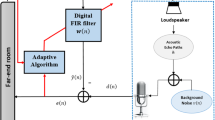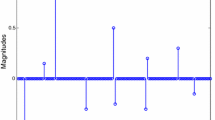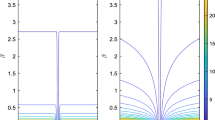Abstract
A new variable-regularized (VR) switch-mode noise-constrained (SNC) transform-domain normalized least mean squares (VR-SNC-TDNLMS) algorithm for adaptive system identification and filtering is proposed. It exploits prior knowledge of the additive noise variance and results in a generalized VR-TDNLMS algorithm with a variable step-size (VSS) for improving convergence speed. It also reduces estimation variance, sensitivity to input signal level and eigenvalue spread by means of variable-regularization and decorrelation transformation. To select the variable step-size online, the convergence behavior of the proposed algorithm is analyzed. From the mean convergence analysis, the maximum step-size (MSS) for convergence is first determined. The theoretical results suggest that improved performance can be obtained if the MSS is employed initially while the NC adaptation is adopted near convergence to reduce steady- state misadjustment. Therefore, a switch-mode scheme which employs a MSS mode together with a NC mode is incorporated to further improve its convergence speed. The mean square convergence behavior is also studied by means of a Lyapunov stability-based method to characterize its convergence condition and steady-state misadjustment. Based on the theoretical results, a new automatic threshold selection method for mode switching is developed. General recommendations for choosing other algorithmic parameters are also proposed to facilitate its online and practical usage. The proposed method is expected to find a wide range of applications in areas related to instrumentation and measurement involving low-complexity and recursive linear estimation. In particular, its potential application and effectiveness in system identification problems and several acoustic applications are demonstrated by computer simulations.







Similar content being viewed by others
Notes
Though the concept of using two or more step-sizes for adaptation is simple intuitively, it is somewhat difficult to be fully utilized in practice as the switching threshold between the operating modes is difficult to be determined.
The measurement noise may result from quantization errors, modeling errors, etc. and is usually assumed to be white Gaussian distributed. In many practical situations, some prior knowledge on noise variances is also available.
References
Chan, S.C., Chu, Y.J, Tsui, K.M., & Zhang, Z.G. (2011). A new switch- mode noise-constrained transform domain NLMS adaptive filtering algorithm. in Proceedings IEEE International Conference Circuits and System, Rio de Janeiro, Brazil, May 15–18.
Haykin, S. Adaptive filter theory. 4th edition, Prentice Hall, 2001.
Nagumo, J. I., & Noda, A. (1967). A learning method for system identification. IEEE Transaction on Automatic Control, AC-12(3), 282–287.
Liu, S. J., Qi, P. P., Wang, J. S., Zhang, M. H., & Jiang, W. S. (2012). Adaptive calibration of channel mismatches in time-interleaved ADCs based on equivalent signal recombination. IEEE Transactions on Instrumentation and Measurement, 63(2), 277–286.
Saha, M., Ghosh, R., & Goswami, B. (2012). Robustness and sensitivity metrics for tuning the extended Kalman filter. IEEE Transactions on Instrumentation and Measurement, 63(4), 964–971.
Kuo, S. M., & Morgan, D. R. (1996). Active noise control systems – Algorithms and DSP implementations. New York: Wiley.
Zhang, Z. G., Chan, S. C., & Wang, C. (2012). A new regularized adaptive windowed lomb periodogram for time-frequency analysis of nonstationary signals with impulsive components. IEEE Transactions on Instrumentation and Measurement, 61(8), 2283–2304.
Narayan, S., Peterson, A. M., & Narasimha, M. J. (1983). Transform domain LMS algorithm. IEEE Transactions on Acoustics, Speech, and Signal Processing, ASSP-31, 609–615.
Chan, S.C., & Zhou, Y. (2008). On the convergence analysis of the transform domain normalized LMS and related M-estimate algorithms,” in Proceedings of IEEE APCCAS 2008, Macao, Nov 30-Dec 3.
Beaufays, F. (1995). Transform-domain adaptive filters: an analytical approach. IEEE Transactions on Signal Processing, 43(2), 422–431.
Chan, S.C., Chu, Y.J, & Zhang, Z.G. (2010). A new regularized transform-domain NLMS adaptive filtering algorithm. in Proceeding of APCCAS 2010, Kuala Lumpur, Malaysia, Dec. 6–9.
Wei, Y., Gelfand, S. B., & Krogmeier, J. V. (2001). Noise-constrained least mean squares algorithm. IEEE Transactions on Signal Processing, 49(9), 1961–1970.
Kwong, R. H., & Johnston, E. W. (1992). A variable step size LMS algorithm. IEEE Transactions on Signal Processing, 40(7), 1633–1642.
Aboulnasr, T., & Mayyas, K. (1997). A robust variable step-size LMS-type algorithm: analysis and simulations. IEEE Transactions on Signal Processing, 45(3), 631–639.
Koike, S. (2002). A class of adaptive step-size control algorithms for adaptive filters. IEEE Transactions on Signal Processing, 50(6), 1315–1326.
Mathews, V. J., & Xie, Z. (1993). A stochastic gradient adaptive filter with gradient adaptive stepsize. IEEE Transactions on Signal Processing, 41(6), 2075–2087.
Vega, L. R., Rey, H., Benesty, J., & Tressens, S. (2008). A new robust variable step-size NLMS algorithm. IEEE Transactions on Signal Processing, 56(5), 1878–1893.
Chan, S.C., Zhang, Z.G., Zhou, Y, & Hu, Y. (2008). A new noise-constrained normalized least mean squares adaptive filtering algorithm in Proceedings of 9 th IEEE Asia Pacific Conference Circuits and System, Macao, China, Dec. 2008.
Chan, S.C., Chu, Y.J., Zhang, Z.G, & Zhou, Y. (2009). On the convergence behavior of the noise-constrained NLMS algorithm in Procedings of IEEE International Conference Circuits and System, Taipei, May 24–27.
Mayyas, K. (2005). A new variable step size control method for the transform domain LMS adaptive algorithm. Journal of Circulation System and Signal Process, 24(6), 703–721.
Harris, R., et al. (1986). A variable step size (VSS) algorithm. IEEE Transactions on Acoustics, Speech, and Signal Processing, ASSP-34, 499–510.
Evans, J. B., Xue, P., & Liu, B. (1993). Analysis and implementation of variable step size adaptive algorithms. IEEE Transactions on Signal Processing, 41(8), 2517–2535.
Fan, J., & Li, R. (2001). Variable selection via nonconcave penalized likelihood and its oracle properties. Journal of the American Statistical Association, 96(456), 1348–1360.
Chen, Y., Gu, Y., & Hero, A.O. (2009). Sparse LMS for system identification. in Proceedings of ICASSP 2009, pp. 3125–3128, Taipei, Taiwan, April 19–24.
Chan, S. C., Chu, Y. J., & Zhang, Z. G. (2013). A new variable regularized transform domain NLMS adaptive filtering algorithm – acoustic applications and performance analysis. IEEE Transactions on Audio, Speech and Language Processing, 21(4), 868–878.
Gelfand, S. B., Wei, Y., & Krogmeier, J. V. (1999). The stability of variable step-size LMS algorithms. IEEE Transactions on Signal Processing, 47(12), 3277–3288.
Chan, S. C., Zhang, Z. G., & Chu, Y. J. (2011). A new transform-domain regularized recursive least M-estimate algorithm for robust linear estimation. IEEE Transaction on Circuits System II, 58(2), 120–128.
Zhang, Z.G., Chan, S.C., Zhou, Y., & Hu, Y. (2009). Robust linear estimation using M-estimation and weighted L1 regularization: Model selection and recursive implementation. in Proceedings of IEEE ISCAS 2009, Taipei, May 24–27.
Kamenetsky, M., & Widrow, B. (2004). A variable leaky LMS adaptive algorithm. Record of the Thirty-Eighth Asilomar Conference on Signals, Systems and Computers, 1, 125–128.
Widrow, B., McCool, J. M., Larimore, M. G., & Johnson, C. R. (1976). Stationary and nonstationary learning characteritic of the LMS adaptive filter. Proceedings of the IEEE, 64, 1151–1162.
Feuer, A., & Weinstein, E. (1985). Convergence analysis of LMS filters with uncorrelated Gaussian data. IEEE Transaction on Acoustic Speech and Signal Process, ASSP-33(1), 222–230.
Quatieri, T. (2001). Discrete-time speech signal processing, Prentice Hall.
Author information
Authors and Affiliations
Corresponding author
Additional information
A preliminary version of the SNC-TDNLMS algorithm was presented in IEEE ISCAS’2011 [1]. An improved version using a maximum step-size mode and variable regularization is proposed in the paper. Moreover, a detailed performance analysis using Lyapunov function for step size selection is presented.
Rights and permissions
About this article
Cite this article
Chan, S.C., Chu, Y.J. A New Variable-Regularized Transform-Domain NLMS Algorithm with Automatic Step-Size Selection for Adaptive System Identification/ Filtering. J Sign Process Syst 84, 181–196 (2016). https://doi.org/10.1007/s11265-015-1036-y
Received:
Revised:
Accepted:
Published:
Issue Date:
DOI: https://doi.org/10.1007/s11265-015-1036-y




